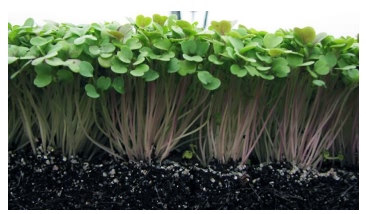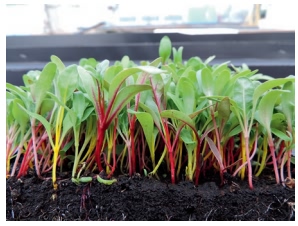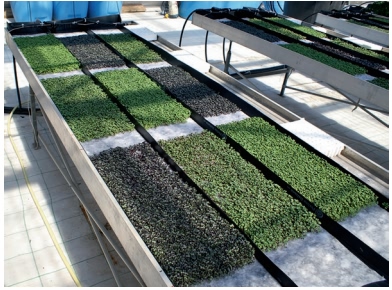सब्जी माइक्रोग्रीनस - पोषण का एक संभावित स्रोत
Microgreens are young and tender edible seedlings produced using the seeds of different species of vegetables, herbaceous plants, aromatic herbs and wild edible plants (Di Gioia and Santamaria 2015a, b). The edible portion constitutes single stem, the cotyledon leaves and, often, the emerging first true leave (Di Gioia et al. 2017).
A few days of photosynthesis of microgreen is known to provide nearly 4-9 times more nutrients including antioxidants, vitamins and minerals than their mature counterparts. Microgreens first appeared in the menus of the chefs of San Francisco, in California, at the beginning of the 1980s.
By geography, North America contribute ~50% of market share in 2019. . During 2020-2025, NutriGreens market at the global level is anticipated to grow at a CAGR (Compound annual growth rate) of 7.5-8.0%.
Traits of Microgreens
The gaining popularity of these cotyledonary leafy greens is due to their pleasing palette of colors, textures and flavors. Microgreens represent a new class of vegetables that can be considered as “functional foods” or “super foods” (Treadwell et al. 2010), because they serve as rich source of bioactive compounds such as vitamins, minerals, and antioxidants, along with the necessary nutrients required for human body (Janovská et al., 2010; Xiao et al., 2012).
Microgreens are frequently called as “vegetable confetti” due to their interesting organoleptic traits and commercial potential. They are known to improve some functions of the organism and/or reduce the risk of cardiovascular disease, protection against inflammatory processes, oxidative stress, obesity, type 2 diabetes mellitus, chronic diseases and cancer.
The group of researchers has analyzed 25 varieties of microgreens for their concentration of different vitamins and carotenoids (Table 1). According to the reports of USDA National Nutrient Database, microgreens have ten times higher antioxidant content than the crops harvested at the commercial stage (Xiao et al. 2012).
Microgreens are also representatives of good source of minerals especially potassium and calcium in addition to their high content of vitamins and antioxidant compounds (Di Gioia et al. 2015b). Presence of minerals in the growing media or in the nutrient solution influence the total content of available minerals in microgreens.
An alternative advantage of microgreens is the short growing season, which reduce the duartion of production and allows the use of free time off work.
Uses of Microgreen
The uses of microgreens enlists in enhancing, garnishing the drinks, salads, appetizers, main and second courses, soups, sandwiches and desserts (Treadwell et al. 2010; Xiao et al. 2012). According to the Di Gioia et al. (2015a) the flavor of most of the microgreens as compared to commercially harvested stage of standard vegetables is not “micro” but are stronger and concentrated.
The Species Utilized
The crops that are selected for commercial cultivation and sale as microgreens should have high value in terms of color (like red or purple), unique textures, or distinct flavors (Fig 1a, Treadwell, et al., 2010 and 1b Di Gioia, et al., 2017), because they are often marketed as specialty mixes, such as “sweet,” “mild,” “colorful,” or “spicy (Treadwell et al. 2010).
The most exploited species for microgreen production belongs to the families of Brassicaceae (e.g. cauliflower, broccoli, cabbage, Chinese cabbage, kale, Savoy cabbage, rappini or brassica raab, watercress, mizuna, radish, arugula, mustard and tatsoi), Asteraceae(e.g. lettuce, endive, escarole, chicory, radicchio), Chenopodiaceae (e.g. Swiss chard, beet, spinach), Lamiaceae, Apiaceae (e.g. dill, carrot, fennel, celery), Amarillydaceae (e.g. garlic, onion, leek), Amaranthceae (e.g. amaranth, red orach) and Cucurbitaceae (e.g. melon, cucumber, squash).
Lettuces cannot be included in the microgreen production because of their delicateness and wilting property.
Production of Microgreen
Seed as a source
Seeds are main source of quality microgreen production which are of major cost (Di Gioia et al. 2015). The seeds of the species selected for microgreen production should be of good quality, high and homogenous germination capacity, free from chemicals, hygienically safe and are of less cost.
The selected species should also have the advantage of growing all-round the year and should be free from particular thermal and environmental prerequisites especially during the period of germination (Di Gioia et al. 2015a).
Microgreens offers the chance of growing in very simple way, in little spaces like a terrace, a balcony or a windowsill, which allows the production of “zeromile” and “low-cost” food (Di Gioia et al. 2017).
Climatic requirements
Microgreens are commercially produced under controlled environment, inside greenhouses or high tunnels using soilless cultivation systems. Microgreens in “containers” constituted by plastic trays and/or synthetic mats that are placed on growing channels or benches (Fig. 2, Di Gioia, et al., 2017), irrigation water and nutrient solution are delivered by nebulization system.
The product can be commercialized along the growing media with containers, which allows the consumer to harvest final product just a few minutes before use. It is also helpful to increase the shelf life and the quality of the product (Di Gioia et al. 2015b).
Now a day’s use of biodegradable containers offers the advantage of minimizing the environmental impact. The other possible systems for production of microgreens are “channels” or on benches and “floating system” which are of less popular.
Growing media
The growing media that are most commonly used for the production are peat, perlite and vermiculite. Use of coconut coir as an alternative organic source to peat offers the advantage of being a renewable source.
The low cost and renewable alternative substrates of recycled fibrous materials like cellulose pulp, cotton and jute fibres, can also be utilized for production of microgreens. The growing medium has an influence on quality especially microbiological quality and yield of microgreens (Di Gioia, 2016).
An ideal growing media should have optimum physical and chemical properties such as a porosity (over 85% of the total volume), a good water holding capacity (55–70% of the total volume), a good level of aeration (20–30% of the total volume) of the root system, pH of 5.5 to 6.5 and an electrical conductivity below 500 μS/cm. Media should also be free from heavy metals and microbiological contamination.
When to Harvest
Plants are harvested when it reaches five to ten centimeters long with the first true leaf leaves and fully developed cotyledonary leaves. Usually plants take 7–21 days from germination to reach harvesting stage depending on the species that has been used (Xiao 2013).
Plants are harvested either manually or using electric knife, by cutting them few millimeter above the growing media (Fig 3). Growing of microgreens in seeding mat offers an advantage of faster harvesting as compared to small tray production (Treadwell et al. 2010).
How to market
It is necessary to wash and precool the produce at 1–5 °C immediately after the harvest (Kyriacou et al. 2016). Another alternative way is to market the product as a whole tray with the growing media which allows the consumer to harvest final product just a few minutes before use, overcome the problems of postharvest loss.
How to handle
Microgreens are highly perishable in nature and senesce rapidly after harvest, because of the sudden disruption in growth of plant at a very early stage. They have a shelf life of 1-2 days even at ambient temperature (Guo and Gan, 2012).
As per the reports of Cross (2008) the main problems in post harvest storage are premature degradation of the crop, which leads to shortening the average shelf life (less than seven days), discoloration, foul odor and rotting.
Shelf life of the harvested produce is mainly influenced by storage temperature, atmospheric composition and respiration rate (Hodges and Toivonen 2008). Storage temperature has significant influence on respiration rate, O2 and CO2 composition, which directly correlates with the rate of cellular metabolism.
From the study of Kou et al. (2013) on buckwheat microgreens, it was clear that the produce stored at 5°C with moderately high O2 (14.0-16.5 kPa) and moderately low CO2 (1.0- 1.5 kPa) concentration showed maximum shelf life. Song et al. (1992) reported the use of modified gas environments, such as modified air packaging and controlled atmosphere storage in combination with lower temperature to increase the storage life of microgreen.
As per the studies of Kou et al. (2014), the pre-harvest spray of 10 mM calcium chloride solution for 10days had a great influence on broccoli microgreens, by increasing biomass, delaying senescence, increasing superoxide dismutase and peroxidase enzyme activity, improved visual quality by decreasing the electrolyte leakage in the plant tissue and reduced microbial growth during storage.
A patented method given by Sasuga (2014) for storage of micogreens had significantly longer shelf life of 10 days as compared to most the other microgreens produced. Moreover, the focus should be given to the methods of “eco-innovative emerging alternative” to enhance the quality characteristics of the product without compromising the shelf life as suggested by Artées-Hernández et al. (2013).
Microgreens are still in infancy stage, need to have more scientific information by expanding the research insight of their potential to consider as super food. Up to date there is no record of foodborne outbreaks by consuming the microgreens, unlike the use of sprouts (Xiao et al., 2014a).
Research status of microgreen
Presently, ongoing research on a number of microgreens at IARI, New Delhi have resulted in the detailed nutritional profiles of the microgreens, and are termed them as Nutri Greens. The new proposal of Micro Fields or growing more than one species of micro greens together in a single tray has the advantage of providing various nutritional compounds to any family for a relatively longer duration.
One Day Online Workshop conducted by Society for Plant Biochemistry and Biotechnology & ICAR-Indian Agricultural Research Institute, New Delhi on “Microgreens for health and wellness “ have released a product called “Tiny Fields” the name given to the group of microgreens being grown together in a tray for healthy diet.


Fig 1a Fig 1b

 Fig. 2 Fig. 3
Fig. 2 Fig. 3
Table 1: Mean Phylloquinone Concentration, β-Carotene, Violaxanthin, and Lutein/Zeaxanthin in 25 Commercially Grown Microgreens (Xiao et al., 2012)
| Name | Phylloquinone (Μg/G FW) | Β-Carotene (Mg/ 100 G FW) | Lutein/Zeaxanthin (Mg/100 G FW) | Violaxanthin (Mg/100 G FW) |
| Arugula | 1.6 ± 0.1 | 7.5 ± 0.4 | 5.4 ± 0.2 | 2.6 ± 0.1 |
| Bull’s Blood Beet | 2.0 ± 0.1 | 5.3 ± 0.8 | 4.3 ± 0.7 | 2.3 ± 0.1 |
| Celery | 2.2 ± 0.1 | 5.6 ± 0.1 | 5.0 ± 0.1 | 2.6 ± 0.1 |
| China Rose Radish | 1.8 ± 0.1 | 5.4 ± 0.5 | 4.9 ± 0.4 | 1.9 ± 0.1 |
| Cilantro | 2.5 ± 0.1 | 11.7 ± 1.1 | 10.1 ± 0.3 | 7.7 ± 0.6 |
| Garnet Amaranth | 4.1 ± 0.0 | 8.6 ± 0.3 | 8.4 ± 0.1 | 4.4 ± 0.1 |
| Golden Pea Tendrils | 0.7 ± 0.0 | 0.6 ± 0.0 | 2.7 ± 0.0 | 1.0 ± 0.1 |
| Green Basil | 3.2 ± 0.1 | 8.4 ± 0.4 | 6.6 ± 0.3 | 2.7 ± 0.2 |
| Green Daikon Radish | 1.9 ± 0.1 | 6.1 ± 0.1 | 4.5 ± 0.1 | 1.7 ± 0.0 |
| Magenta Spinach | 0.6 ± 0.0 | 5.3 ± 0.3 | 3.2 ± 0.2 | 3.7 ± 0.5 |
| Mizuna | 2.0 ± 0.0 | 7.6 ± 0.4 | 5.2 ± 0.3 | 2.4 ± 0.1 |
| Opal Basil | 2.0 ± 0.1 | 6.1 ± 0.4 | 5.3 ± 0.3 | 2.0 ± 0.0 |
| Opal Radish | 2.2 ± 0.2 | 6.3 ± 1.0 | 5.5 ± 0.9 | 2.3 ± 0.4 |
| Pea Tendrils | 3.1 ± 0.2 | 8.2 ± 1.1 | 7.3 ± 1.2 | 3.9 ± 1.4 |
| Peppercress | 2.4 ± 0.2 | 11.1 ± 0.6 | 7.7 ± 0.4 | 3.1 ± 0.2 |
| Popcorn Shoots | 0.9 ± 0.0 | 0.6 ± 0.1 | 1.3 ± 0.1 | 0.9 ± 0.1 |
| Purple Kohlrabi | 2.3 ± 0.1 | 5.7 ± 0.2 | 4.0 ± 0.1 | 1.5 ± 0.0 |
| Purple Mustard | 1.3 ± 0.1 | 5.6 ± 0.4 | 6.4 ± 1.9 | 1.0 ± 0.2 |
| Red Beet | 1.9 ± 0.1 | 7.7 ± 0.1 | 5.5 ± 0.0 | 3.7 ± 0.0 |
| Red Cabbage | 2.8 ± 0.1 | 11.5 ± 1.2 | 8.6 ± 1.0 | 2.9 ± 0.3 |
| Red Mustard | 1.9 ± 0.1 | 6.5 ± 0.4 | 4.9 ± 0.3 | 1.7 ± 0.1 |
| Red Orach | 0.7 ± 0.0 | 6.3 ± 0.3 | 3.9 ± 0.2 | 3.2 ± 0.2 |
| Red Sorrel | 3.3 ± 0.0 | 12.1 ± 0.6 | 8.8 ± 0.2 | 3.6 ± 0.1 |
| Sorrel | 1.7 ± 0.1 | 5.2 ± 1.0 | 4.2 ± 0.8 | 1.3 ± 0.3 |
| Wasabi | 1.9 ± 0.1 | 8.5 ± 0.2 | 6.6 ± 0.3 | 2.2 ± 0.2 |
Reference
Artés-Hernández, F., Gómez, P. A. and Artés, F. 2013. Unit processing operations in the fresh-cut horticultural products industry: Quality and safety preservation. In Food Quality, Safety and Technology, Springer, Vienna. pp. 35-52.
Cross, P. 2008. Charybda Farms personal interview: Dec 12, 2008.
Di Gioia, F. and Santamaria P. 2015a. The nutritional properties of microgreens. In: Di Gioia F, Santamaria P (eds) Microgreens. Eco-logica editore, Bari, pp 41–47
Di Gioia, F. and Santamaria, P. 2015b. Microgreens, agrobiodiversity and food securoty. In: Di Gioia F, Santamaria P (eds) Microgreens. Eco-logica editore, Bari, pp 7–24
Di Gioia, F. and Santamaria, P. 2015a. The nutritional properties of microgreens Las propiedades nutricionales de las micro-hortalizas. In: Di Gioia F, Santamaria P (eds) Microgreens. Eco-logica editore, Bari, pp 41–47.
Di Gioia, F. and Santamaria, P. 2015b. Microgreens, agrobiodiversity and food security. Microgreens. Novel Fresh and Functional Food to Explore all the Value of Biodiversity. In: Di Gioia F, Santamaria P (eds) Microgreens. Eco-logica editore, Bari, pp 7–24.
Di Gioia, F., De Bellis, P., Mininni, C., Santamaria, P. and Serio, F. 2016. Physicochemical, agronomical and microbiological evaluation of alternative growing media for the production of rapini (Brassica rapa L.) microgreens. Journal of the Science of Food and Agriculture, 96, DOI: 10.1002/jsfa.7852.
Di Gioia, F., Mininni, C. and Santamaria, P. 2015b. Ortaggi di Puglia, tra biodiversità e innovazione: il caso dei micro-ortaggi. In: Somma AR (ed) Il Giardino Mediterraneo, vol II. Mario Adda Editore, Bari, pp 154–164.
Di Gioia, F., Renna, M. and Santamaria, P. 2017. Sprouts, microgreens and “baby leaf” vegetables. In Minimally Processed Refrigerated Fruits and Vegetables, Springer, Boston, MA, pp. 403-432.
Guo, Y. and Gan, S. S. 2012. Convergence and divergence in gene expression profiles induced by leaf senescence and 27 senescence‐promoting hormonal, pathological and environmental stress treatments. Plant, Cell & Environment, 35(3): 644-655.
Hodges, D. M. and Toivonen, P. M. 2008. Quality of fresh-cut fruits and vegetables as affected by exposure to abiotic stress. Postharvest Biology and Technology, 48(2): 155-162.
Janovská, D., Stocková, L. and Stehno, Z. 2010. Evaluation of buckwheat sprouts as microgreens. Acta Agriculturae Slovenica, 95(2): 157.
Kou, L., Luo, Y., Yang, T., Xiao, Z., Turner, E. R., Lester, G. E Wang Q. and Camp, M. J. 2013. Postharvest biology, quality and shelf life of buckwheat microgreens. LWT-Food Science and Technology, 51(1): 73-78.
Kou, L., Yang, T., Luo, Y., Liu, X. and Huang, L. 2014a. Pre-harvest calcium application increase biomass and delays senescence of broccoli microgreens. Postharvest Biology and Technology, 87: 70-78.
Kyriacou, M. C., Rouphael, Y., Di Gioia, F., Kyratzis, A., Serio, F., Renna, M., De Pascale, S. and Santamaria, P. 2016. Micro-scale vegetable production and the rise of microgreens. Trends Food Science and Technology, 57:103–115.
Sasuga, D. G. 2014. Providing microgreens eg celery product with significantly longer shelf life than most other microgreens products. Patent WO2014117034-A2.
Song, Y., Kim, H.K. and Yam, K.L. 1992. Respiration Rate of Blueberry in Modified atmosphere at various temperatures. Journal of the American Society of Horticultural Science, 117(6): 925-929.
Treadwell D. D., Hochmuth, R., Landrum, L. and Laughlin, W. 2010. Microgreens: A new specialty crop. EDIS, 3.
Xiao, Z. 2013. Nutrition, sensory, quality and safety evaluation of a new specialty produce: microgreens. Ph. D. Thesis, College Park, University of Maryland.
Xiao, Z., Lester, G. E., Luo, Y. and Wang, Q. 2012. Assessment of vitamin and carotenoid concentrations of emerging food products: edible microgreens. Journal of agricultural and Food Chemistry, 60(31): 7644-7651.
Xiao, Z., Luo, Y., Lester, G. E., Kou, L., Yang, T. and Wang, Q. 2014a. Postharvest quality and shelf life of radish microgreens as impacted by storage temperature, packaging film, and chlorine wash treatment. LWT-Food Science and Technology, 55(2): 551-558.
Authors:
BHANUSHREE N1 , B.S. TOMAR2
1Ph.D. Scholar, 2Head
Division of vegetable science, ICAR-IARI, New Delhi – 110012
email:
